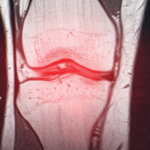‘The synovial compartment is equipped to function as an inflammatory survival niche for plasma cells. And it could indicate the sustained ACPA production facilitated by this environment could contribute to the chronicity of synovial inflammation in RA.’ —Dr. Scherer
He said the results indicate the synovial compartment is a microenvironment that promotes the survival of these ACPA-IgG secretions.
“This indicates that the synovial compartment is equipped to function as an inflammatory survival niche for plasma cells,” Dr. Scherer said. “And it could indicate the sustained ACPA production facilitated by this environment could contribute to the chronicity of synovial inflammation in RA.”
He said researchers are only “at the very beginning” of understanding exactly how the synovial fluid provides such a great environment for these plasma cells to produce ACPA-secreting cells.
Researchers looked for factors that could promote the survival of these plasma cells for so long, but haven’t identified anything specific yet. But that has been hampered, perhaps, by the complex culture that’s involved, making it difficult to identify the cells or survival factors of interest.
“We did not see a specific signal coming up,” he said. “That could also have to do with the fact that it’s a very mixed culture in which we don’t know how many of the cells that are still in there are actually the ACPA-IgG-producing” cells.
Autoreactive Memory Plasma Cells
In another talk, Andreas Radbruch, PhD, professor of rheumatology at Charité University in Berlin, said autoreactive memory plasma cells—which essentially give inflammation a memory, making it difficult to extinguish—present “a therapeutic challenge.” They can be generated in the preclinical stage of RA and continuously after that.
The levels of autoantibodies maintained despite immunosuppressive therapy are an indication of the memory plasma cells that are secreting them.
“They are refractory to conventional immunosuppressive therapy, such as glucocorticoids, anti-TNF or anti-CD20 antibodies, aiming at the termination of ongoing immune reactions,” he said. “Memory plasma cells secreting pathogenic antibodies thus can provide the memory of chronic inflammation.”
The memory cells don’t live long by themselves, but are aided by survival factors, such as anti-Vascular Cell Adhesion Molecule 1 and a proliferation-inducing ligand.
“Understanding the lifestyle of memory plasma cells has provided strategic options to target them, but so far almost all therapeutic options do not discriminate between pathogenic and protective plasma cells, and thus imply loss of humoral memory and increased risk of infections,” Dr. Radbruch said. “The therapeutic challenge is to ablate pathogenic plasma cells selectively and maintain protective humoral memory as much as possible, and to prevent regeneration of memory plasma cells from their precursors.”

